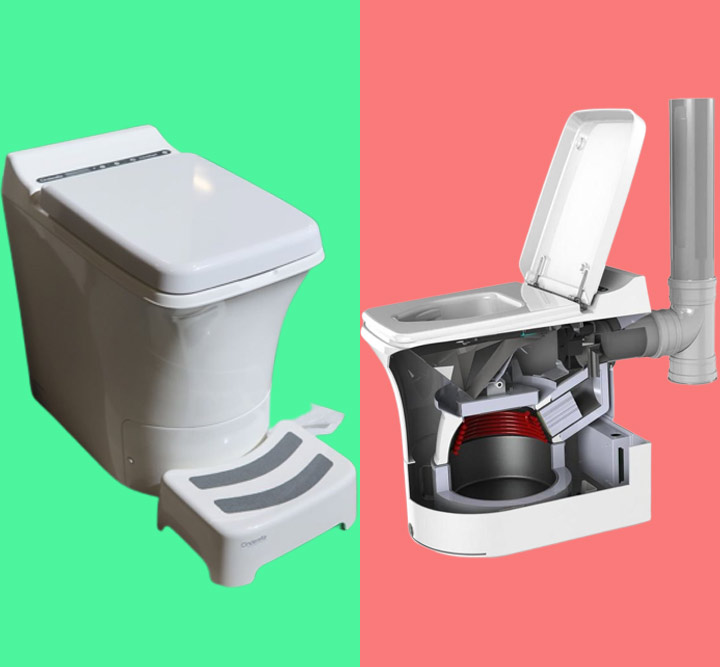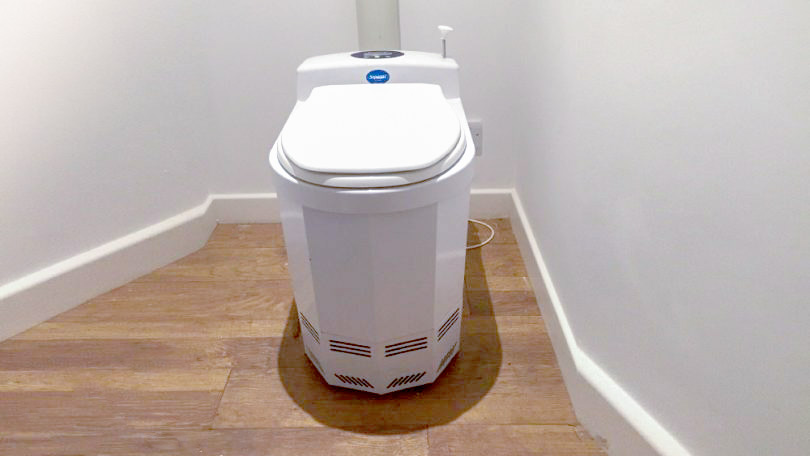Incinerator toilets are self-contained, waterless units that dispose of the waste by burning it at high temperatures and then turning into ash.
The ash is bacteria-free, which is equivalent to just one teaspoon of waste for four people after a week of use.
An incinerator toilet doesn’t need to be attached to an in-ground septic system or a sewer system. You’ll need it for unheated places in your home or other establishments that are vulnerable to cold.
Most other toilet systems require plumbing and drainage systems to carry the end waste to an appropriate deposit. However, with an incinerating toilet, you will get decomposable ash, which is ideal for fertilizing your garden.
This type of toilet can be used even in the most remote places where there is no water supply or an expensive drainage solution. Different types of incinerating toilets use gas and electricity as an energy source.
How Does an Incinerating Toilet Work?
Incinerating toilets depend on electric power or natural or propane gas to burn human waste and transform it into germ-free, clean ash. However, you need to empty electric incinerating toilets more often when compared to propane toilets. When the toilet is full, you will have to turn on the incinerator.
The cycle time varies depending on what type of incinerating toilet you use. It can be as short as 30 to 40 minutes for an electric unit or up to four hours for gas-powered incinerators. When the incineration cycles, the internal chamber heats up to 1400° F.
The electric incinerating toilet sits in your bathroom with electric exhaust pipes that exit through the roof. The pipes vent smoke and fumes out of your house when the cycle runs so there’s little to no smell. You need batteries to run an electric incinerating toilet, or you can plug it into a wall outlet.
The waterless system of an incinerating toilet looks much like a usual household toilet. Some mechanical and function al differences are present between electric and gas incinerating toilets but the overall treatment procedures are the same.
Both take the human waste in its liquid and solid forms to process into the internal chamber.

Pros of an incinerating toilet
- No drainage connections or water supply necessary
- Childproof
- Odor-free
- Needs small space
- Not reliant on an electric mains supply
- Comparatively simple to use and maintain than other types of toilets
- No waste handling required, just a small amount of ash needs to be emptied
- Requires less cleaning as there are special liners
- No need to supply bark, chemicals, etc.
- Excellent for boondocking and conserves energy well while boondocking
- No bug issues
- Can be used in below-freezing temperatures
- Durable
- The small size suits RVs
Cons of an incinerating toilet
- High energy cost
- Doesn’t work in an off-grid scenario
- Doesn’t work with solar panels
- Some may find it unpleasant to use
- Destroys composting nutrients
- Very expensive
- Inconvenient if you need to apply a liner before every use
- The liners used are a little expensive
- Pollutes the atmosphere around you
- Needs venting
- Tiresome and expensive to maintain
FAQs
1. How much does it cost to run an incinerating toilet?
Ans. The price range of an incinerating toilet is from $1500 to $2000, and the system costs about 28 Cents per cycle to function . A four-people electric unit is $2,300, an eight-people toilet is $2,700. On the other hand, a propane incinerating toilet will set you back around $2,500 while a natural gas incinerating toilet will cost the same.
2. How much electricity do incinerating toilets use?
Ans. An incinerating toilet needs a consistent power supply because one complete cycle uses around 1½ to 2 kWh depending on the type of use (solid or liquid) and the number of users.
3. How much propane do incinerating toilets use?
Ans. You can use it 40-60 times before requiring an incineration cycle. Generally, an entire 100 lb cylinder can burn 16 max capacity loads, which is around 960 times of use. You would get an average of 75-100 incineration cycles on one 20 lb propane bottle.
4. Do incinerating toilets stink?
Ans. Since these toilets use electric heat to burn and then transform waste into a little amount of germ-free ash (about one tablespoon per use), they’re totally odor-free.








Leave a Comment